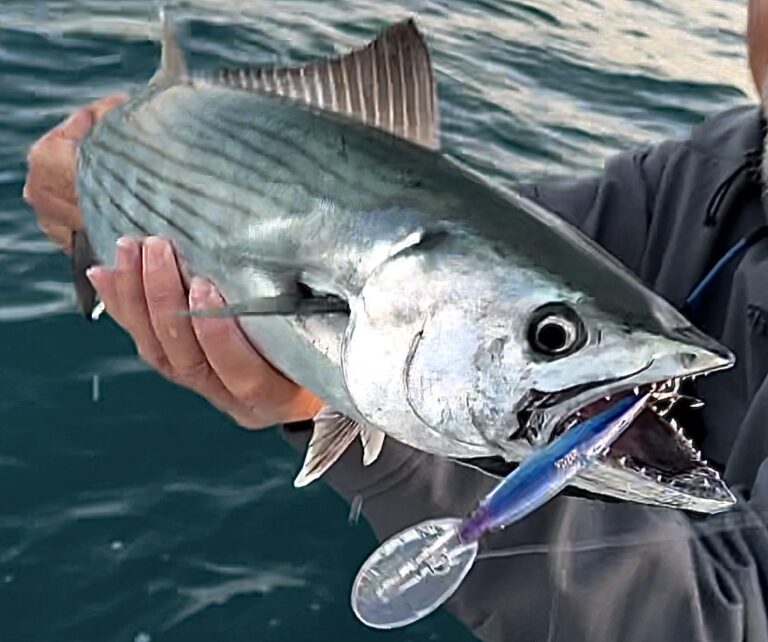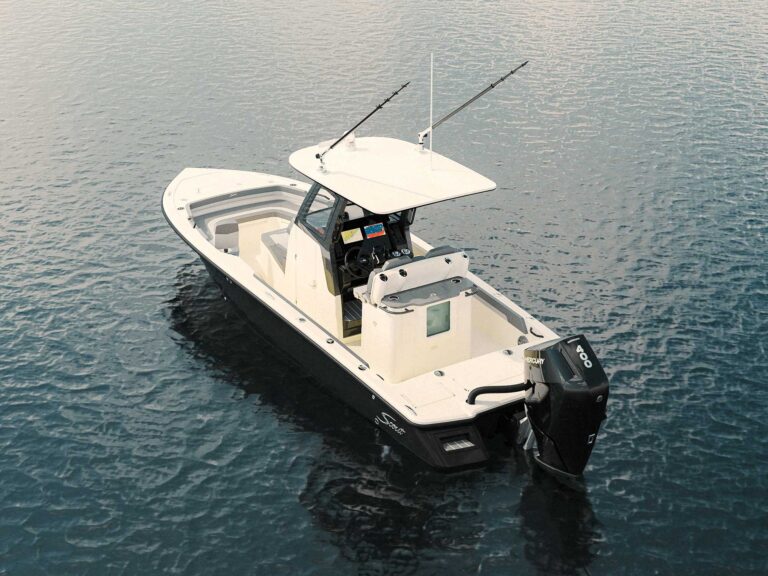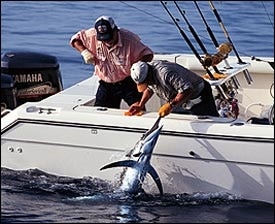
| David Glenn, right, and Nick Malinovsky wrestle with a blue marlin hooked off the northern end of Long Island. |
The blue marlin attacked the long ‘rigger lure without warning, jolting my wife and me out of that trance-like state one lapses into after trolling for many hours without a strike. We had been working a textbook-perfect rip off Columbus Point, the southeastern point of Cat Island in the central Bahamas, and it had finally paid off.
At first the blue ran deep, causing us to wonder if we had actually hooked a tuna. But the fish’s impulse to jump took over after a few seconds, and jump it did, clearing the water nine or ten times before sounding again. My wife, Poppy, already had the rod fastened to her standup harness by the time the fish settled down, then moved to the bow of our 28-foot center console for the fight.
Fifteen miles west, Captain Robert “R.T.” Trosset of Key West was fishing for tuna at Tartar Bank, an underwater seamount that rises to within 45 feet of the surface. I called him on the radio and said I sure could use a wireman to help while I photographed the fish. He radioed back that he was on the way.
Poppy settled into a rhythm, slowly working the marlin toward the surface. The fish had gone very deep, and now it was a vertical game. She maintained steady pressure, and soon began to gain a few feet of line with each stroke. It was a tough fish, but it eventually tired after two more half-hearted attempts at jumping.
R.T. arrived right as the fish broke the surface. He jumped aboard the Poppy B and led the marlin to the side of the boat, where we photographed and measured it, then spent the next 15 minutes reviving it. The fish measured out just shy of 200 pounds. It was one lucky marlin, because it had a Japanese longline hook still embedded in its jaw! It had survived two encounters with humans and swam away from both.
Family Fun Spot
Earlier that week, my family and I had traveled 300 nautical miles to this remote area of the Bahamas aboard our 28-foot Whitewater. Also making the trip were Trosset and his family aboard their 28 Sea Vee Spindrift and David Glenn and Jay Check of Pursuit Boats on a brand-new 3070 Offshore Center Console. Our gathering off Long Island was based on reports of fantastic fishing, related by friends and charter captains who had been fortunate enough to get here.
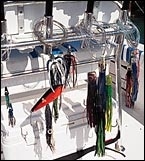
A variety of trolling lures, many of them rigged ahead of ballyhoo, proved effective on the offshore grounds.|
Our plan was to fish the waters at the mouth of Exuma Sound from both the north and south sides. Long Island sits at the southern end of this area, with Cat Island marking the northern end. Both islands offer excellent marinas and hotels, and are about as far out as you can get if you need these facilities. Only San Salvador and Rum Cay are farther, the former being 50 miles east of the southern end of Cat Island. Rum Cay lies some 27 miles east of the northern end of Long Island. Once you get south of Rum Cay, into the extreme southern Bahamas, there really aren’t any facilities for boats.
Our first stop was the resort community of Stella Maris on Long Island. We wanted to fish the reefs off Cape Santa Maria, the northern shore of Long Island, which was named after Christopher Columbus’ ship of the same name. The waters of Exuma Sound run very deep, with the 1,000-fathom curve not far from shore. Shallow fingers of reef extend north from Cape Santa Maria into these deeper waters, and the reefs attract everything from marlin and wahoo to tunas and dolphin as currents swirl over them, forming incredible rips like the one where we found our marlin.
Working the Reef
On our first morning at Stella Maris, R.T. castnetted some Bahamian pilchards in the marina (which also contained a huge school of bonefish each morning) and set out to catch tunas, Key West-style. Our three boats worked around the reef, encountering huge flocks of terns just about everywhere we went. Anticipation ran high, because we were sure the tuna would be thick.
We were right, except for one problem that we hadn’t anticipated: sharks. R.T. quickly became frustrated after losing one tuna after another to the unseen and undoubtedly numerous sharks lurking below, so we abandoned that strategy and decided to troll off the reefs in deeper water.
The next day, all three boats made the short run to Rum Cay and spent the morning trolling with no success. We worked our way northwest to Conception Island, an uninhabited and beautiful cay that is a Bahamian park. Near Conception we again encountered large flocks of birds, and as we trolled back towards Long Island the ocean came alive. The radio suddenly crackled to life as the Pursuit team called to say they had hooked a blue marlin. The fish had eaten a small lure intended for tuna, and David Glenn was fighting it on 30-pound test.
Sharks were in the back of everyone’s mind after the fish went deep and the minutes began to tick away. The ocean was flat calm, and we just sat and watched as David slowly inched the fish to the boat. Just as Nick Malinovsky got set to wire the marlin, two sailfish popped up 100 yards away, their sails fully extended, lazily swimming along the surface. R.T. tossed them a live bait, but they wanted no part of it. Shortly thereafter, David’s marlin was released and we all headed for the barn.
Exuma Tuna
The next day we rode north to Hawk’s Nest, a resort and marina on the southwest shore of Cat Island, to try the northern end of Exuma Sound. That’s where we found Poppy’s marlin off Columbus Point. The water off Cat Island doesn’t get quite as deep as quickly as off Long Island, but there are still many spectacular drop-offs and edges, along with immense rips that run almost to shore in some spots.
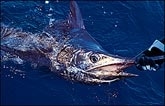
One lucky marlin! Poppy Brownlee’s 200-pound blue had already survived an encounter with a longliner before being released a second time.|
Tartar Bank rises from surrounding waters that are 500 fathoms deep to less than 50 feet, and it’s a famous wintertime wahoo spot. We spent some time bottom fishing there, and R.T. caught numerous exotic black snappers by dropping live bait on the edge of the bank.
Similarly, Columbus Point features steep ledges and drop-offs along a finger of reef extending southeast from shore for several miles. On a subsequent trip to Cat Island we found dolphin and yellowfin tuna by the hundreds at Columbus Point. The dolphin were cooperative to the point of being a nuisance, while the tunas proved more difficult to catch.
We netted pilchards inside the newly renovated marina at Hawk’s Nest, adopting R.T.’s proven method of live-chumming to attract the fish, which proved deadly on the tunas. We would run the edge of the tuna birds, shut down and begin tossing pilchards overboard by the net-full. The tunas would instantly swarm around the boat, where they were easy to hook on the live baits.
However, as soon as the first tuna was hooked, an oceanic whitetip shark would appear behind the boat. These spooky-looking creatures ate over half the tuna we hooked, until we finally hooked one of them on a tuna head, which kept it occupied for a while. The sharks would chase the first couple of tunas as they were hooked, eating them in the depths. After that, however, they would simply hang around behind the boat and wait for us to bring the tunas to them, eating them ten feet from the boat.
We caught yellowfin to 55 pounds at both Tartar Bank and Columbus Point, with most of the fish weighing around 35 pounds. The live bait provided truly outstanding action, although some other boats at the marina also caught some respectable yellowfin by trolling. One of the benefits of using live bait is that you can hook the fish on any tackle you want. My son Ben caught one on a plug rod, somehow managing to get it past the sharks. And I hooked a beautiful fish on a fly rod and fought it 45 minutes, only to have it eaten at boatside. Heavier tackle is advisable in this part of the world!
Both Stella Maris and Hawk’s Nest offer excellent fishing in a part of the Bahamas that is not yet heavily fished. The lack of crowds and the close proximity of the fishing grounds make both marinas outstanding destinations for the private-boater. It’s a hike to get there, to be sure, but the beauty of the area and the plentiful and cooperative fish make it well worth the trip.
| ### Stella Maris Resort ClubThe Stella Maris Resort Club is spread out over considerable real estate along the eastern shore of Long Island. A plantation-style resort, it features everything from simple hotel rooms to cottages, townhouses and even luxury single-family homes with swimming pools. We stayed in a gorgeous three-bedroom home known as the Rainbow House, perched on a cliff above the ocean. The clubhouse and restaurant sit high atop the crest of the island, offering spectacular views of the Atlantic. Jorg Friese is your host.The marina is located on the west coast of Long Island, several miles down the road from the resort, so a taxi or rental car is needed. The marina is a well-protected basin and offers fuel, electricity and water. There’s even a marine railway and a surprisingly neat and well-equipped machine shop on the premises. This is a great place to have work done on your boat, should the need arise.For more information, contact Stella Maris Resort and Club, Long Island, Bahamas; (800) 426-0466 or (242) 338-2051; fax (242) 338-2052; www.stellamarisresort.com.### Hawk’s Nest Resort and MarinaJust inside Hawk’s Nest Creek, at the southwestern end of Cat Island, sits Hawk’s Nest Resort and Marina, the only marina on the entire island. The formerly tiny marina has recently undergone extensive renovation, expanding to 28 slips with new docks and offering gas and diesel fuel, electricity, ice and water. Future plans include a restaurant and bar at the marina, and the resort now operates its own charter boat. Hawk’s Nest Hotel is a beautiful spot just down the road from the marina (you get there by golf cart). It offers ten comfortable guest rooms on the beach, a two-bedroom cottage at the entrance to the creek, a lively bar and an excellent restaurant. There’s a 4,600-foot runway at the hotel, too, making it a great place to leave your boat and fly in and out.For more information, contact Hawk’s Nest Resort and Marina, Cat Island, Bahamas; (800) 688-4752 or (242) 342-7050; fax (242) 342-7051; www.hawks-nest.com. |





